Pickleball, paddle tennis, and padel are all similar racket sports that have been gaining popularity during recent years. These three sports seem very similar at first glance. But, once you understand the differences between them, it becomes clear which one may be more appealing to you and your family’s skill set.
Read on to find out more as we compare the three sports!
- What is pickleball?
- What is Paddle Tennis (POP Tennis)?
- What is Padel?
- Paddle Tennis, Pickleball, and Padel Sports Equipment
- The Differences in Court Dimensions
- Gameplay – How are they different?
- Serving style
- Game scoring
- Relative fitness demands
- So what is Platform Tennis?
- Is Padel the same as Paddle Tennis?
- Can you play pickleball on a paddle tennis or padel court?
What is pickleball?
Playing pickleball is a fun activity that combines elements of tennis, badminton, and ping-pong. It is played both indoors and outdoors on a badminton-size pickleball court and a slightly modified tennis net. In this sport, a pickleball paddle, court shoes and a plastic ball with holes are utilized. It can be played as doubles or as singles, and everyone can enjoy it, regardless of their skill level and age. The rules are simple and easy to learn and it is easy to start playing pickleball.
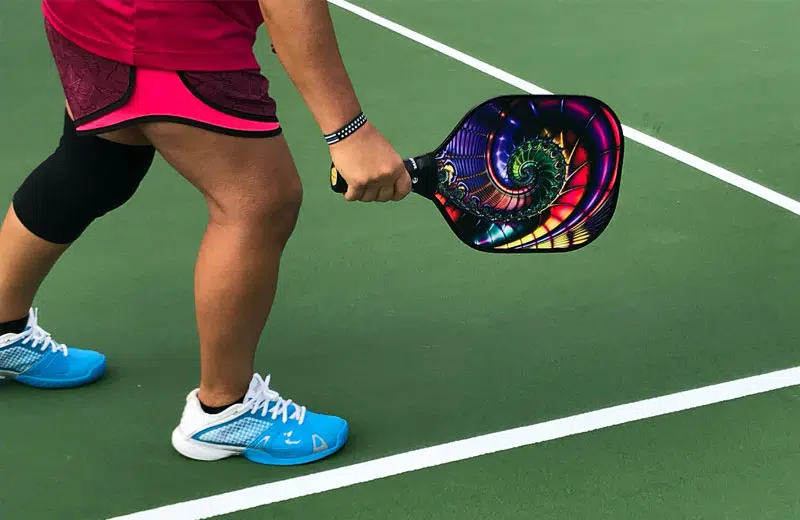
Pickleball history
Pickleball was developed in 1965 by Joel Pritchard and friends on Bainbridge Island, Washington. It was created to be a sport that could be played in Pritchard’s backyard.
Pickleball evolved from simple origins–largely handmade equipment and simple rules–into a popular sport in the US and Canada. The game is becoming more popular in European and Asian countries as well, with courts being added all over.
In America, Pickleball is regulated and promoted by the USA Pickleball Assciation (USAPA).
What is Paddle Tennis (POP Tennis)?
Pop Tennis is a new form of tennis with a twist on traditional paddle tennis. Played on shorter courts with shorter (no strings) racquets and lower compression tennis balls (green dots for adults, orange dots for kids), Pop Tennis follows the same rules and scoring system as Tennis, but players get one underhanded serve.
Played all year round, indoors or outdoors, it can be played by all ages on classic 50-foot courts as well as 60-foot courts.
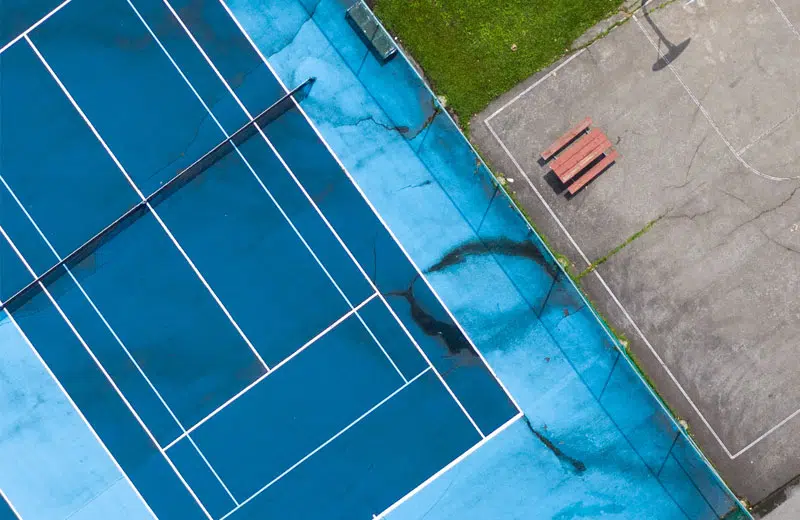
History of Paddle Tennis (Pop Tennis)
The sport was invented in 1915 by an Episcopal minister, Frank Peer Beal, in lower Manhattan. Wanting to provide a recreational activity for neighborhood children, he got the city’s parks and recreation department to lay courts in Washington Square Park in Greenwich Village.
By 1941, it was played in 500 American cities. It is not to be confused with Platform Tennis, which is a different racquet sport.
What is Padel?
Padel (or Padel tennis) combines tennis and squash. It’s a racket sport that’s full of fun, action, and social interaction. This game is ideal for all ages and abilities since points are won more by strategy than by sheer strength.
It is played in doubles on an enclosed court made of glass and mesh, which is about a third the size of a tennis court. Since the game is easy to learn, it can be played by a variety of skill levels, making it ideal for families.
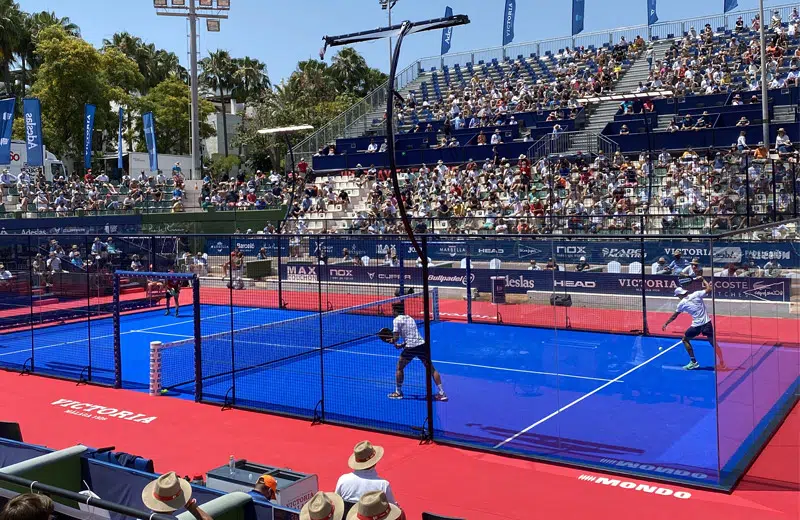
History of Padel
Padel, sometimes called padel tennis, originated in the Mexican beach resort of Acapulco in 1969. The founder of Padel, Enrique Corcuera, was a wealthy businessman who didn’t have enough space to install tennis courts. So, he decided to build a court that could be played with less powerful strokes.
The sport became extremely popular in Mexico and has since expanded into the U.S., Europe, Canada, South America, and Asia. The official rules of padel were established in 1992, with the creation of The International Federation of Padel (FIPA).
Paddle Tennis, Pickleball, and Padel Sports Equipment
What do you need to play Pickleball?
You will need to use a beginner’s pickleball paddle when playing pickleball, which is smaller than a tennis racquet but larger than a ping-pong paddle. Pickleball paddles were originally made of wood which has evolved to mainly comprise aluminum and graphite, among other lightweight composite materials.
Additionally, players will need a net and a pickleball. With holes in it, the ball is unique. You can play with different ball models indoors and outdoors. What’s the difference between pickleball balls and wiffle balls? Pickleballs are slightly heavier than wiffle balls.
Equipment needed for Paddle Tennis (Pop Tennis)
This sport requires a solid racquet, sometimes called a paddle. With a memory foam core, it’s made of carbon fiber, fiberglass or a similar material. They have holes and no strings on the striking area. Paddles for POPs are allowed to have some grit or texture on their faces, but cannot be modified once approved and received by the manufacturer.
The official ball is the “Green Dot” because it has an internal pressure of 75% as compared to a standard tennis ball. A “Orange Dot” ball (50%) can be used for children’s POP and for beginners who prefer a slower pace.
Equipment to get started with padel
Padel requires a padel racquet that is made of glass fiber or carbon fiber and has a foam core. Padel racquets are available in different shapes that provide unique in-game properties.
Additionally, you will need padel balls that are the same size as a regular tennis ball but have less pressure. Three balls are used at the same time during a game.
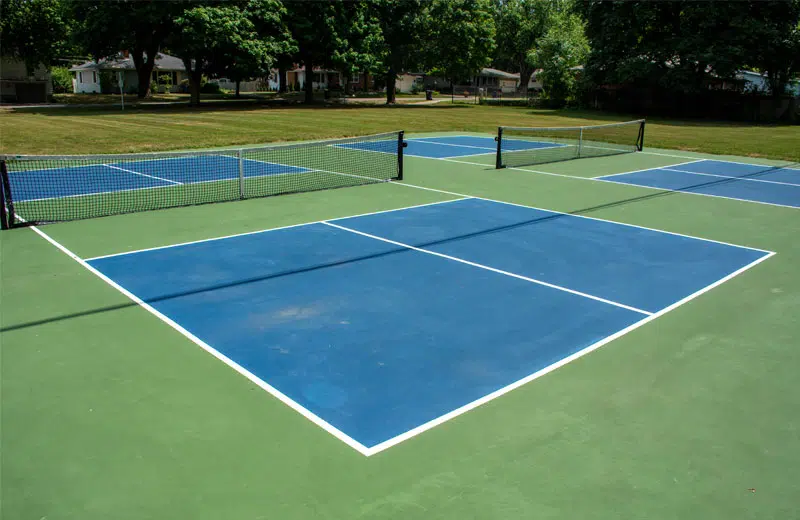
The Differences in Court Dimensions
Pickleball courts measure 20 x 44 feet, the same size as a doubles badminton court. In pickleball, you can play singles or doubles on the same court. There is a net height of 36 inches on the sidelines and 34 inches in the middle. In addition to right and left service courts, there is a no volley zone of 7 feet in front of the net (referred to as the “kitchen”). Courts can be built specifically for pickleball or converted from tennis or badminton courts.
A Paddle Tennis court is smaller than a tennis court. POP Tennis’ court sizes are 60′ x 21′ for singles and 60′ x 27′ for doubles. POP Classic (original paddle tennis) takes place on a 50′ x 20′ court. The United States alone has over 30,000 POP Tennis courts.
Padel courts are rectangular, 32ft 8in (10 meters) wide, and 65ft 7in (20 meters) long, longer than pickleball and paddle tennis courts. Courts are enclosed by solid walls (fully at the ends, partially on the sides). The playing field is divided into two by a net with a height of 34,6 inches in the center (88 cm) and 36 inches on either side (92 cm). It’s important that the surface be completely smooth.
The service lines are located three meters in front of the back wall, and there will be an additional line in the middle that divides the central rectangle in half. Lines should have a width of 5 cm and be clearly visible.
Gameplay – How are they different?
There’s a reason paddle tennis and pickleball are often confused. Both of these games are played in a similar manner. Other kinds of similar sports tend to use racquets. These sports use paddles. If you don’t know the differences between pickleball and paddle tennis, you may assume they are the same game.
There is a major difference with padel as the game is played on an enclosed court with four surrounding walls. The court is also larger than pickleball or paddle tennis courts. This allows for a more dynamic game and longer rallies.
Serving style
This is one of the major differences between pickleball, paddle tennis, and padel.
In pickleball, the serving rules are quite strict. The players are only permitted to serve once. They can only serve underhandedly. It is also strictly forbidden for players to let their balls touch the no-volley zone when serving.
The no-volley zone is the area of the court that extends backward from the net point.
Paddle tennis, on the other hand, tends to be more accommodating. While players also get only one serving opportunity, they can serve however they want. Players can take advantage of their strong serving style by maximizing it.
The serving rules are relatively strict in padel. A player gets two chances to serve, but they have to serve underhanded and below the waistline.
Game scoring
Pickleball is typically played to 11 points and you must win by 2. There is no deuce (or tiebreaker game); instead, pickleball uses a pickle-off, which determines the first player or team to reach 7 points with the winner having two pickles – thus scoring 1 point – left in their pickleball pickle-pail.
Paddle tennis is typically played to 7 or 11 points and you must win by 2. There is no deuce (or tiebreaker game); instead, padel uses a padel point, which determines the first player or team to reach 3 points with the winner having 1 point – thus scoring 1 padel point – left.
Padel uses the same scoring system as regular tennis, including deuce and tiebreaker games. The first player or team to win 6 games reaches the setpoint, with the first player or team reaching 2 sets winning the match. Both games and tiebreaks have to be won by at least two points.
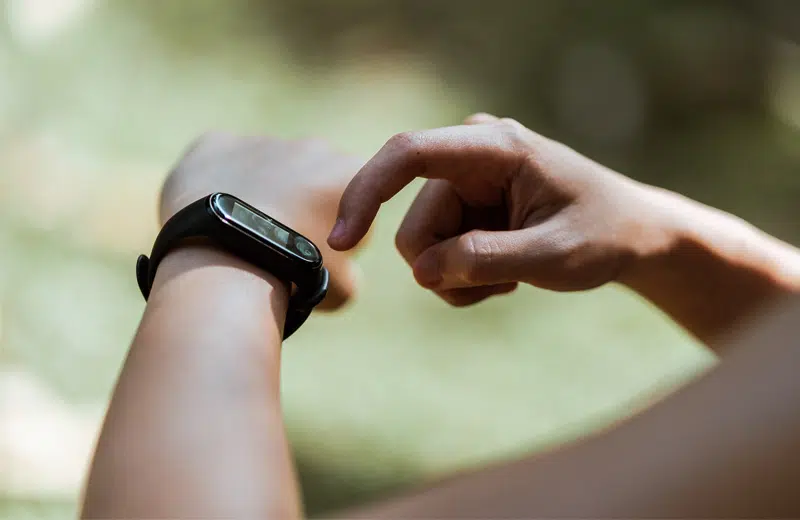
Relative fitness demands
Research suggests pickleball is a relatively low-impact sport. The pickleball player’s heart rate typically ranges from 120-150 bpm.
Paddle tennis has been shown that a paddle tennis player’s heart rate normally ranges from 120-140 bpm.
Padel has been shown to be more physically demanding than both paddle tennis and pickleball. A pickleball player’s heart rate typically ranges from 130-160 bpm.
So what is Platform Tennis?
Is Platform Tennis the same as Paddle Tennis? No. Platform tennis was first referred to as paddle tennis when it became a sport in 1928.
After the game was legitimized and the courts were raised up on platforms, it became known as “Platform Tennis” since the court was upon platforms – unlike traditional tennis and other racquet sports.
The sport of platform tennis is typically played in cool or cold weather, although it has become a year-round activity in some regions.
Is Padel the same as Paddle Tennis?
No, padel is sometimes referred to as padel tennis, which is not the same as Paddle Tennis – a different sport.
Can you play pickleball on a paddle tennis or padel court?
No, pickleball is played on pickleball-specific court.
Recommended:
